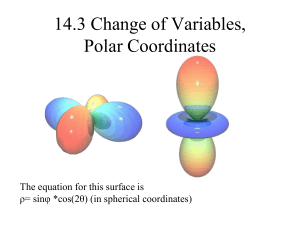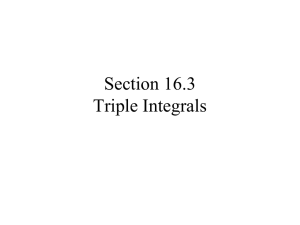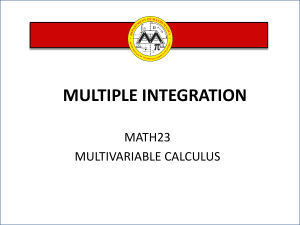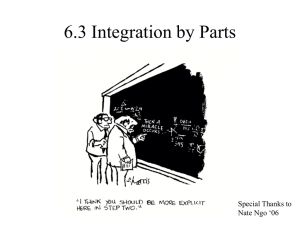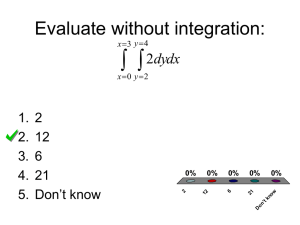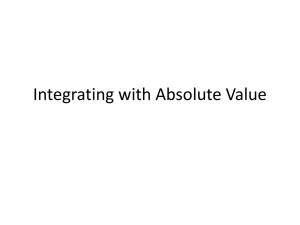Multiple Integration - Iterated Integrals and Area in the Plane
advertisement
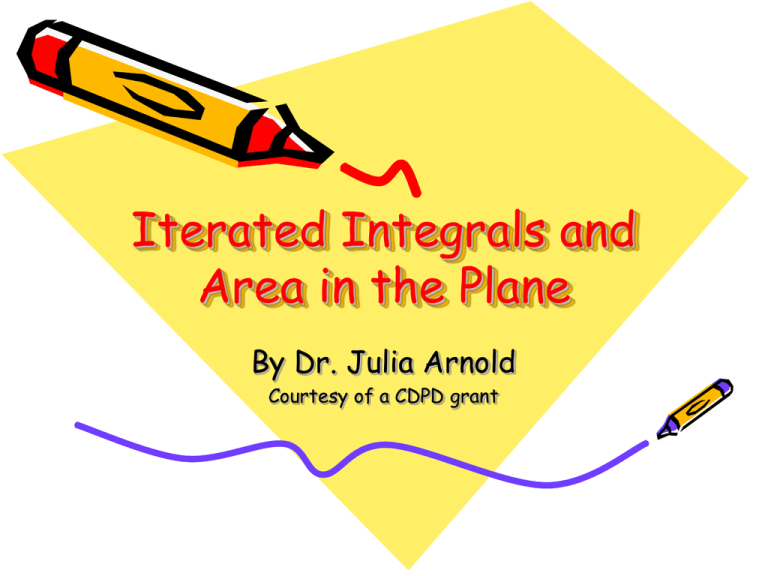
Iterated Integrals and Area in the Plane By Dr. Julia Arnold Courtesy of a CDPD grant Objectives of this section: 1. Evaluate an Iterated Integral 2. Use an iterated integral to find the area of a plane region Objective 1 Evaluate an Iterated Integral Definition of an Iterated Integral Just as we can take partial derivative by considering only one of the variables a true variable and holding the rest of the variables constant, we can take a "partial integral". We indicate which is the true variable by writing "dx", "dy", etc. Also as with partial derivatives, we can take two "partial integrals" taking one variable at a time. In practice, we will either take x first then y or y first then x. We call this an iterated integral or a double integral. Notation: Let f(x,y) be a function of two variables defined on a region R bounded below and above by y = g1(x) and y = g2(x) and to the left and right by x = a and x = b then the double integral (or iterated integral) of f(x,y) over R is defined by The first integration gives us a function in x second gives us a numerical value. Let’s look at an example while the Example 1: Evaluate the iterated integral 3 2 2 x y dydx The order the dx dy is in determines which you do first. 0 1 3 2 0 1 2 [ x y dy] dx x 2 y 2 2 x 2 22 x 212 3 x 2 0 2 1 dx and since 2 2 2 3 3x 2 0 2 3 3 x 3 x 3 3 27 27 dx 0 6 2 0 2 2 We integrate with respect to y holding x term like a constant. Evaluate it at its limits. Then we integrate with respect to x and evaluate it at its limits. Example 2: Evaluate the iterated integral 4 x 2 ye x dydx This is the solution to the first integral: 1 1 x x 1 1 2 ye dy dx 4 4 xe x x 2 ye x dy y e 1 e x dx using parts 0 xe x 2 x 4 1 4 4 1 4e e 4 1 e e 2 x x e x 12 e x xe x e x 1 Hint: start with u = e-x and dv=(x – 1) Objective 2 Use an iterated integral to find the area of a plane region Let’s begin by finding the area of a rectangular y region. d R c a b x y If we integrate with respect to y first we would go from c to d. d Then integrate with respect to x and we would go from a to b. R c a b x b d b a c a dydx d c dx (d c)(b a) Which is the same as length times width. Example 2: Use an integral to find the area of the region. y Y goes from 0 to x2 y 2 4 4 x2 x goes from 0 to 2 2 4 x 2 0 dydx Using a table of integrals 0 2 4 x 2 1 x2 2 2 dy dx 4 x dx x 4 x 4 arcsin 0 0 0 2 2 0 1 2 1 0 2 2 4 4 4 arcsin 0 4 0 4 arcsin 2 2 2 2 2 x 2 arcsin1 2 arcsin 0 2 2 20 Since we know this is ¼ of a circle we can verify by using the traditional formula. Exercise: Use an iterated integral to find the area of the region bounded by the graphs of the equations. xy 9, y x, y 0, x 9 First let’s sketch the bounded area. y It looks like we might need to divide this into two problems. Since the left area is of a right triangle we could save time and use the formula. x Exercise: Use an iterated integral to find the area of the region bounded by the graphs of the equations. xy 9, y x, y 0, x 9 Triangle area 1 9 3 3 and 2 2 3 x x2 3 9 0 0 dydx 2 0 2 area on right 9x 9 9 9 9 dy dx dx ln x 9 ln 9 9 ln 3 9 ln 9 ln 3 3 0 3 x 3 3 9 Total Area +9ln3 2 9 y x You may be wondering if you integration. The answer is be easier than the other. Exercise: Sketch the region order of integration. 0 can switch the order of yes. However, one way may R of integration and switch the 4 2 y f ( x, y )dydx y y x 2 and 0 y 4 y x2 4 x Exercise: Sketch the region order of integration. R of integration and switch the y Switched 4 2 0 f ( x, y )dxdy y y x 2 and 0 y 4 y x2 4 2 x2 0 0 f ( x, y)dydx x Last Exercise Sketch the region R whose area is given by the iterated integral. Then switch the order of integration and show that both orders yield the same area. 0 x 4 y 2 and 2 y 2 2 4 y 2 2 2 dxdy 2 0 2 y3 2 4 y dy 4 y 3 2 2 3 2 4 2 4 2 3 3 3 8 8 8 8 16 16 32 3 3 3 3 Last Exercise Sketch the region R whose area is given by the iterated integral. Then switch the order of integration and show that both orders yield the same area. 0 x 4 y 2 and 2 y 2 x 4 y2 y2 4 x y 4 x We will need two double integrals in this order. 4 4 x 0 4 0 4 dydx 0 dydx 0 4 x 4 4 0 0 1 2 4 xdx 4 xdx 2 4 x (1)dx 0 4 1 2 2 4 x (1)dx 4 4 x 3 0 4 4 4 3 3 2 4 4 0 3 3 2 0 3 2 4 0 32 32 3 3 For comments on this presentation you may email the author Dr. Julia Arnold at jarnold@tcc.edu.
